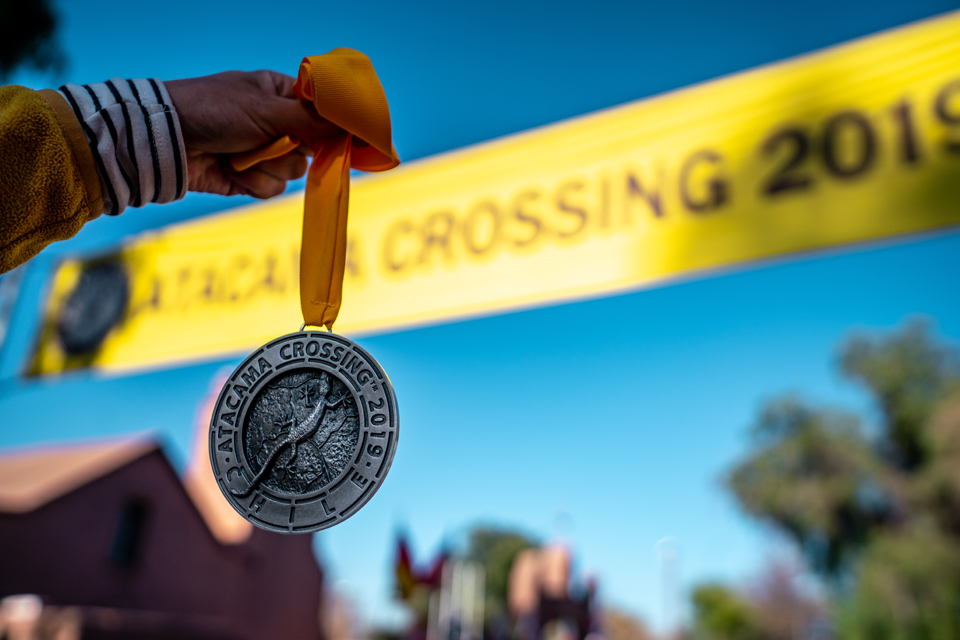Written by Sarah Oppermann
Sarah Oppermann, Ireland / Stage wins: 2 / Finishing Position: 5th Female 24th Overall/ Finishing Time: 39 hours 37mins 45
What and where: The Atacama Crossing (by RacingThePlanet) is a 250km, six stage self-supported race. Carrying all you need for the week on your back, the distances are daunting, but it is the terrain that really elevates the difficultly of this race! Cliché as it may be but mental preparation and kit preparation are as important as the physical training required for this race.
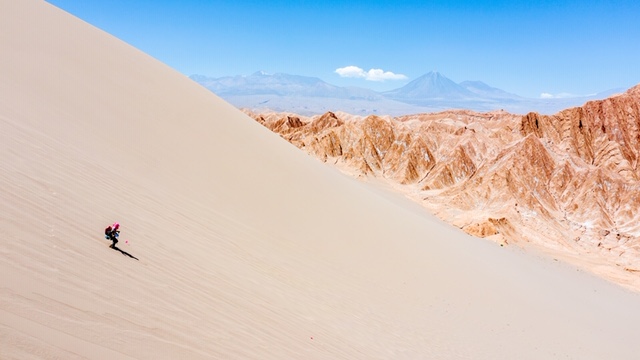
The Atacama Desert is the driest desert in the world (50 times drier than California’s Death Valley with some areas having never experienced rainfall). Originally under the sea it now comprises a plateau of 181,300 sq.km of salt basins, sand, lava flows and salt flats (more like dry frozen broccoli). Due to its strange outworldy appearance, the Atacama has been used as a location for space scenes in films and its low levels of artificial light make it a world renowned destination for star gazing.
Nutrition and Training: Competitors must carry everything they need (nutrition, clothes and medication) for the week. We had to carry 35 mandatory items e.g. (toilet tissue, sleeping bag, eating utensils, headlamps etc) along with a minimum of 14,000 calories. I took about 16,000 calories which was not enough! I counted my recovery drinks and gels into my calorie intake which I may not do next time. A pre-race kit inspection and spot checks during the race ensure competitors take the kit requirements seriously. If you run out of kit/nutrition and borrow something from someone you may face a time penalty- so preparation really is key.
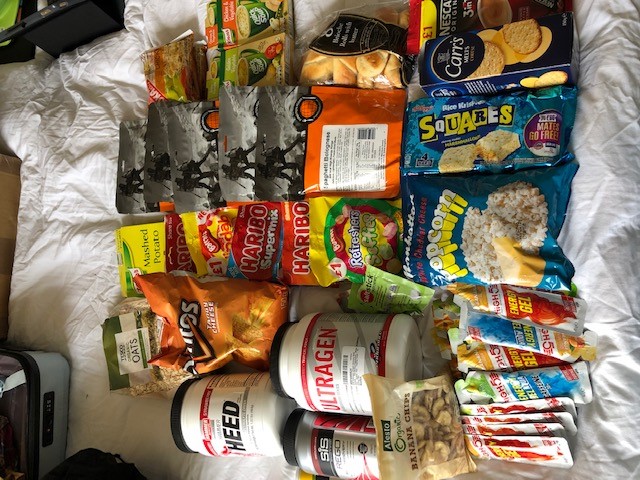
Perfecting the balance between taking enough food for a week with not having an unreasonably heavy bag can only be achieved with practice. I became fixated with what foods contained the highest calories, but weighed the least. I smashed noodles and Doritos into powder and weighed everything I carried (sample below). I cut the end off my toothbrush. I decided against any spare clothes and only carried the mandatory clothing items. I rented a great sleeping bag (Phantom 32) that folded up really small. I rationed my tissue paper for the week. I cut all the pieces of plastic off my contact lens cases/medicine packs. I cut off unnecessary zippers and I repackaged my food into airtight zipfoil. What would usually seem essential for a week in the desert was left behind (no insect repellant, eyedrops, topical disinfectants). I had taste tests during long runs to see how my body reacted to the freeze dried meals (Expedition Foods- will use again!). Some things worked, some things didn’t. One good experiment was using a lesser-known product on my feet to harden them (Tuffoot- typically used for horses’ hooves) which meant I was comfortable only carrying the minimum blister/bandage requirements. A big mistake was taking the back protector out of my OMM backpack (for a 400gr saving). In the end my backpack was around 9.5kg which was about the average with plenty of improvements identified for next time.
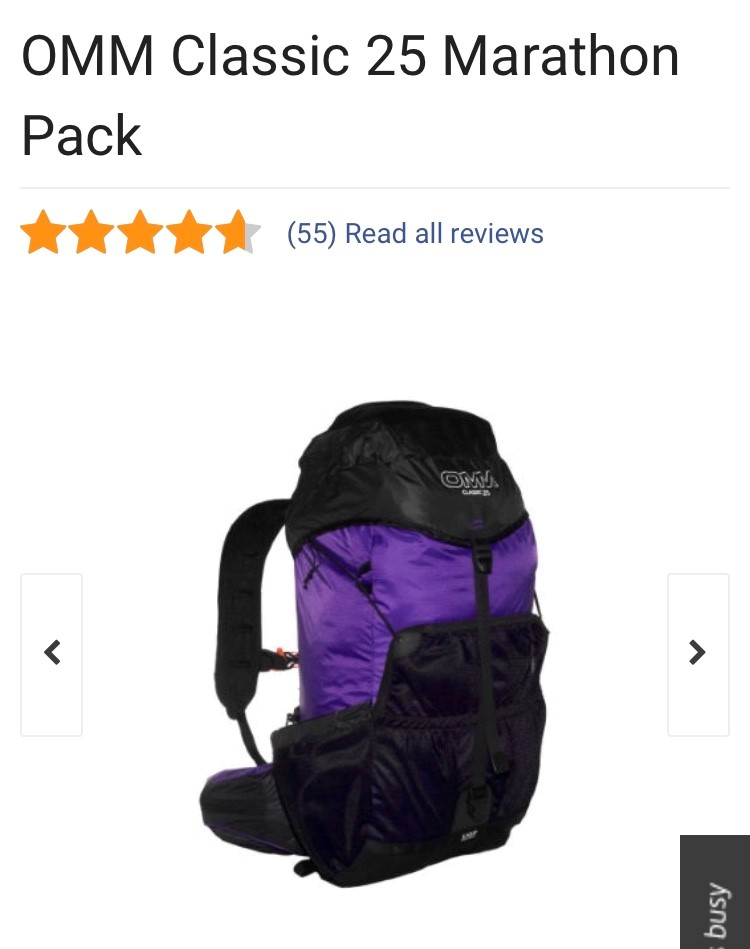
Training ranged from 70km to 120km a week, with a long road run every week and on average one long hill run a week. Every long run was done with my back pack (then about 5-6kg) which helped with slowing the pace down (essential for sustaining this type of training). The longest day of the race (80km) was prepared for by doing two 70km runs during a ten day heavy mileage cycle.
Snips of my spreadsheets below:


Stage 1: 35km- Navigation by Rock
Description of course: Through rolling hills of Rainbow Valley and along the Ancient Inca Road. Loose and soft red ground with some areas of compact gravel/stoney surfaces.
Altitude: Starts at 10,518ft- finish at 8,625ft
Most difficult stage: Last 6km through a canyon with no shelter from the blistering heat
Stage Place: 5th female
“You cant turn the wind- so turn the sail” (African Proverb)
The day before Stage one all competitors met in a local hotel for a pre-race briefing, kit check and final feed before a string of buses drove us to Camp 1. After a final meal of fresh food brought from town and some introductions we settled into our 6 man tents and I had a surprisingly easy (but freezing) sleep.
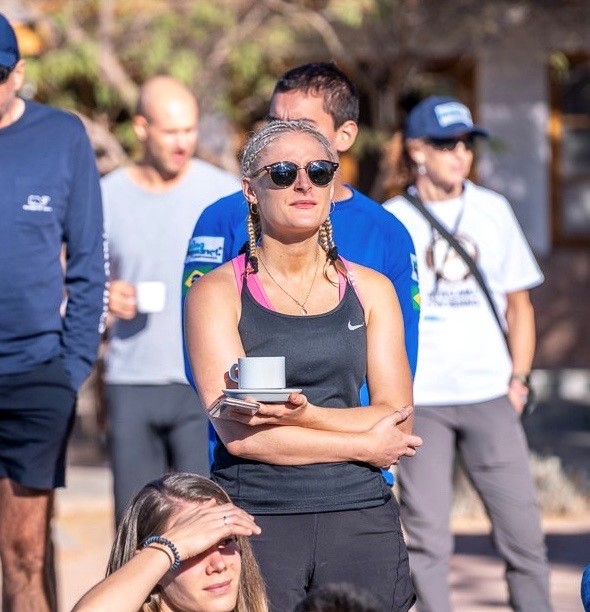
After Samantha (RacingThePlanet) gave us our early morning briefing, the time went so quickly and day one started with a bang- and a lesson in adapting. I knew that something at some stage would go wrong and had been preparing myself mentally for any eventuality. However, I had not prepared for something unexpected to happen so early in the race. The first couple of kilometres were going well – the first stage is enjoyable with some rolling hills and rock plateaus. About 13km in a couple of us at the start of the second pack could not find any pink course markers for about 2km. Ama (Australia), Petra (Slovakia) and I decided to keep running forward and eventually a course steward gave us some directions to follow to the next checkpoint (a shepherd had removed the pink markings). By the time I reached the second checkpoint I was completely rattled- I don’t think I even stopped for water. I felt like we had just wasted hours of time and energy trying to find our way and I decided the only thing I could do was boot it through the blistering sun for the last third of the race. I was so disappointed coming into Camp that I didn’t even check my finishing time. I let that situation get the better of me. If I had done that I would have seen that those who finished before were a manageable time ahead. A really great lesson in controlling the controllables that day.
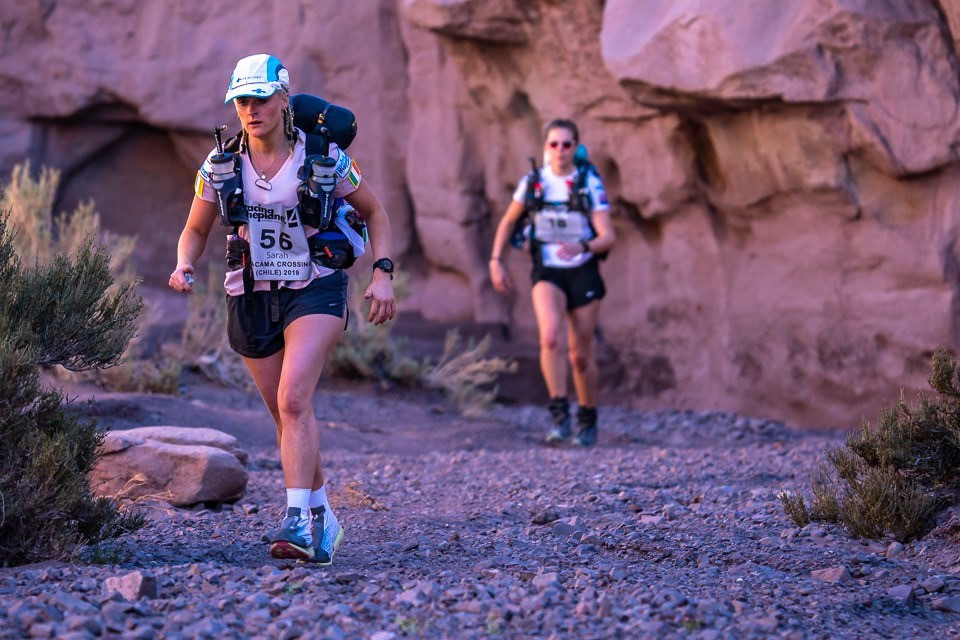
Stage 2: 36.9km The Slot Canyons
Description of course: Through many water crossings through slot canyons of the San Pedro River, onto the mountain ranges and the Valley of Death into the open terrain of the Salar of Atacama.
Altitude: Starts at 8,625ft- finish at 7,661ft
Most difficult stage: over 20 river crossings but the closest thing to a shower all week!
Stage Place: 7th female
Daytime in the Atacama is a dry exposed heat but the night time is really really cold. The only way to get warm in the morning is to be up as quickly as possible and head out to the fire that sparks up at around 5am. Sleepwear consists of: stance socks, hat, gloves, leggings, a lululemon longsleeve and a northface down jacket. My waterproof windbreaker serves as a pillow and my sleeping bag has a hood so I am fully covered. Breakfast each morning is some oats and dried banana in water washed down with instant nescafe. By the end of the week my plastic bowl tasted of chicken soup, oats, coffee and noodles all in one!
Stage two consists of a dirt track down to the San Pedro river which we have to cross (over 20?) times for about 10km. It’s a pretty amazing experience, requiring lots of concentration, many climbs and descents. I ran the first half of the day with Nicola (Italy), Tanja, Rafeal (Germany), Andy (UK) and Troy (Canada). I tried to keep a pretty quick pace hoping to make up for lost time from day one. After the river crossing, we run through some flat lands, up a valley and a tunnel onto the ridges of the RIO Salado. Things got very fairly hairy quickly after that- I completely overheated. By the time I ran down the
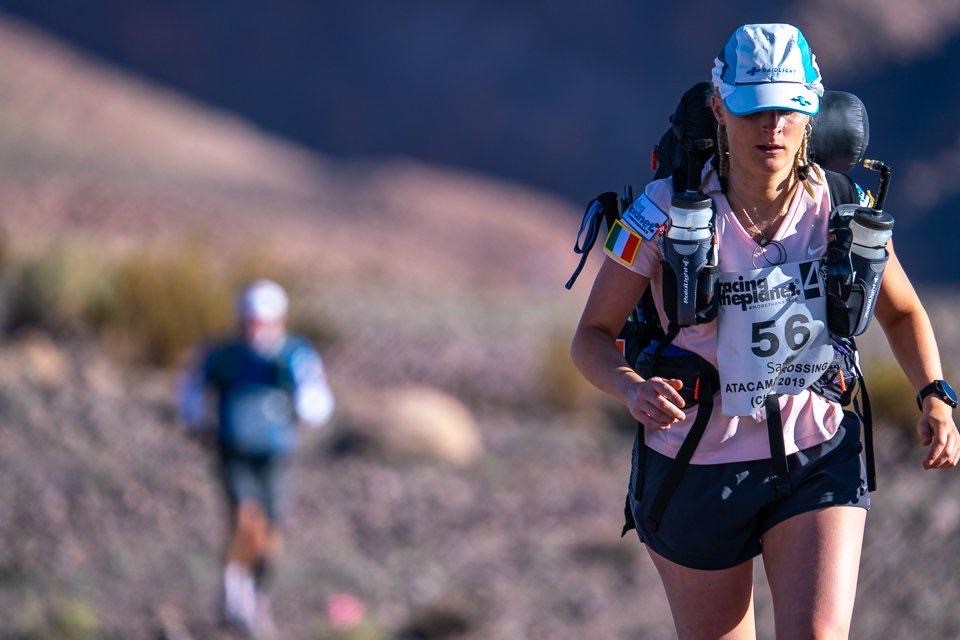
biggest dune ever to the Valley of Death I was pretty delirious. I was taking in as many electrolytes as I could to keep myself from getting heat stroke and could only watch as Corinna (Germany) and my tentmates Ben and Natalie (UK) passed me out in the last seven km. I’m not sure where I finished stage two- 7th perhaps. The last thing I remember was getting water sprayed on my face as I reached the camp.
Stage 3: 38.9km The Atacamenos Trail “the Real Atacama”
Description of course: Cross country across some low vegetation with some sandy and slate terrain with canyons and sand dunes. Some crusty hard packed crusty mud. Final climbs up sand dunes to Camp 4.
Altitude: Starts at 7,661ft- finish at 8,048ft
Most difficult stage: Final climb to camp but really a great day
Stage Place: 1st female
It is strange trying to compete when you don’t have access to your family and friends, a phone and any of the ordinary comforts we typically rely on. If you don’t eliminate self-doubt quickly your mental state can deteriorate pretty quickly. I was getting quite frustrated with how the first two stages were going and it was Petra (Slovakia) and Natalie (UK) who advised me to pace myself how I normally would for Day 3. That’s what I did and things started to turn around from there.
Stage three is basically cross country along the Atacamenos Trail through hard slate, salt flats, some vegetation, and some canyons and sand dunes thrown into the mix. Everyone said this was where we would see the “real Atacama”. There was also a road for a couple of km which I was very happy about- I ran this part with Ash (Atacama veteran) and Nicholas (Australia) who was helpfully blaring music for that whole stage!. It felt like mostly a flat terrain besides a steep (vertical) climb at the end. I forced myself to pace, ignore those around me and look to speed up at the end (how I typically run my races back home). It is difficult to do that when you don’t know what terrain is lying ahead but it is what I should have been doing all along. In the last 6/7km I made my move and looked to speed up. I remember asking Benji (one of the fantastic stewards) at the second last checkpoint who was ahead and when he said there was only one- (Deb (Australia)- fabulous runner and eventual winner) I knew I had enough in me to push and be the first woman home. It was a great day. The end of this stage is a vertical climb up a sand dune and we watched every person finish the stage as their heads popped into view.
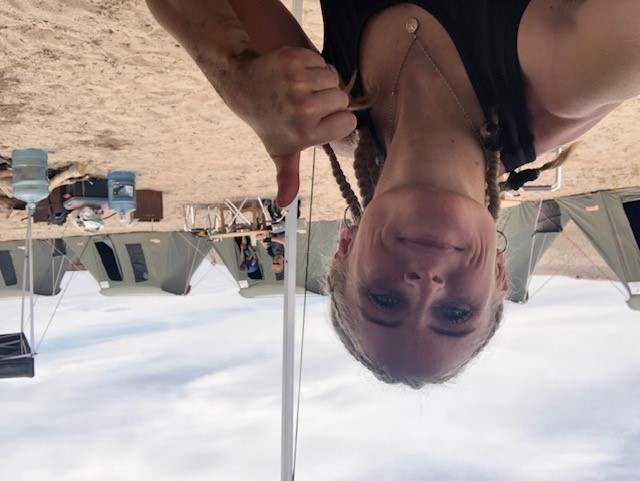
I knew I would have to acknowledge the pain in my lower back at some point and decided now was the time to do it. I went to the medical tent which was filled with a constant stream of people. Blisters on blisters, blisters inbetween toes, blisters under nails, blisters hidden by dirt, blisters stuck to socks, shredded feet, twisted ankles. “have you seen his blister?” became as normal as saying good morning. I have never seen such ripped up feet. I learnt from the doctors that the key to blisters is to pop them both sides straight away, drain it, dress it and cover it. Cover the area well enough that your bandage becomes a second skin. Do not remove the bandage. If you ignore your blisters you start to lose more and more skin on your foot and it is game over. I had worked on my feet the months before the race so my blisters weren’t my downfall but my back was in a bad way. 10kg rubbing off my back without any back protector and it was feeling raw. Patrick the medical director strapped it up which was a great relief for the following days.

Stage 4: 46.3km The Infamous Salt Flats
Description of course: True variety! Some steep hills, loose rock on sand, through a small village, through a river valley, open salt plains and the infamous salt “flats”
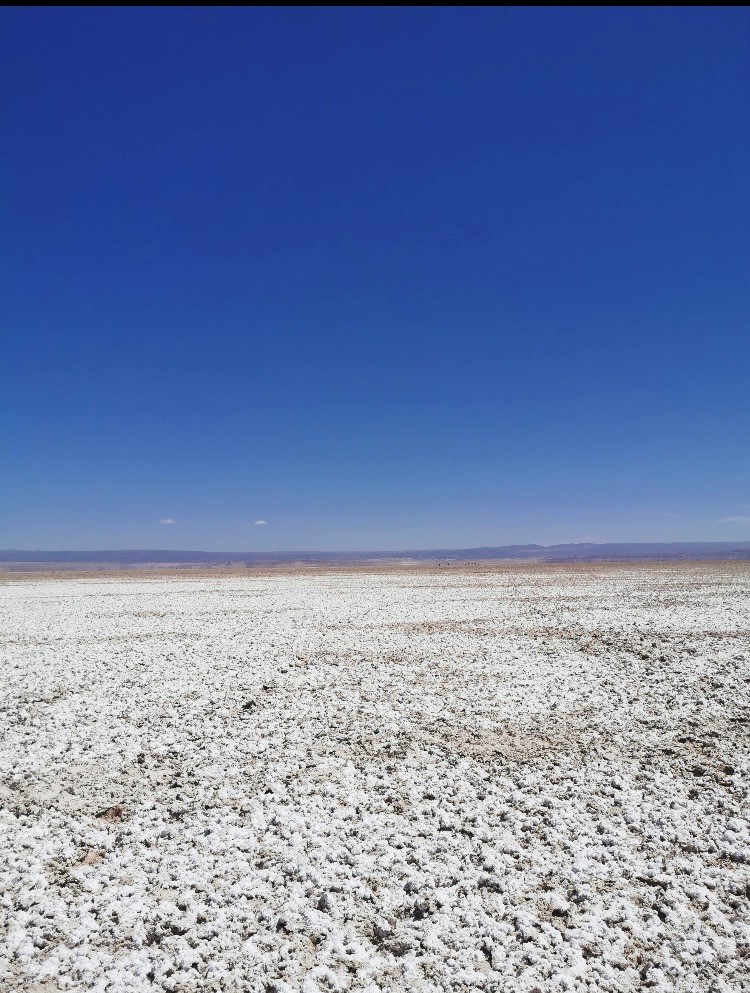
Altitude: Starts at 8,048ft- finish at 7,598ft
Most difficult stage: Second half of the course- 6km of salt flats- impossible to run on, near impossible to walk on and one twisted ankle away from an early ending! Such an experience!
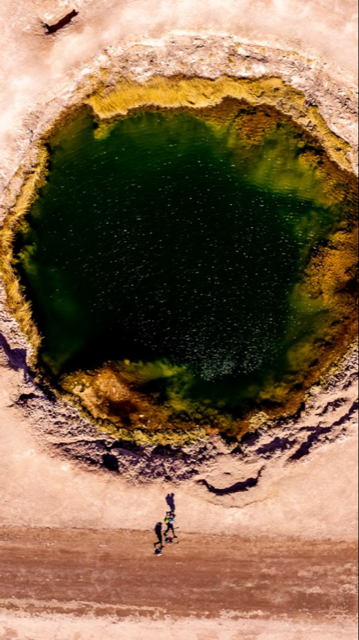
Stage Place: 2nd female
At our morning briefing we were warned that the salt flats are near possible to reach by vehicle so to be very careful about hydration, twisted ankles and sunburn. Salt flats is a really misleading name. There is nothing flat about the salt flats in the Atacama. They are like really sharp shards of freeze dried broccoli that don’t crumble when you step. The day started with a couple of river crossings through river Valle Jerez, some dune climbs through Tambillo Forest (following Anim!) a run through a village, some long stretches of sand plane and gravel. Then- the salt flats. I had heard from a couple of the veterans that once the salt flats finished it was flat ground through a donkey path for miles. I got through the flats and picked up the pace (it helped that I was being hunted by Chigon (South Korea), Corinna (Germany) and Marc (France)). The final 6km is a long stretch of road completely exposed in the midday sun- past a huge lagoon. All I could see was Tanja and Rafeal (Germany) ahead of me and I just chased and chased and chased. Tanja took first but it was a great moment!
I had forgotten I had 80km ahead the next day. I had completely redlined it- after about 30 minutes of crossing into camp I couldn’t eat anything and had to spend some time in the medical tent. These doctors had seen everything in four days and while they tolerated me in the tent for a while when it was clear I wasn’t going to die I knew I had to give someone else a space. The people competing in this race were absolute warriors- people were so determined to finish. Helen (Malaysia) had some form of ankle injury that required regular medical attention- she was the biggest warrior. My race buddy Ama (Australia) had a stress fracture so prominent that the doctors were taking pictures of it to show people back home.
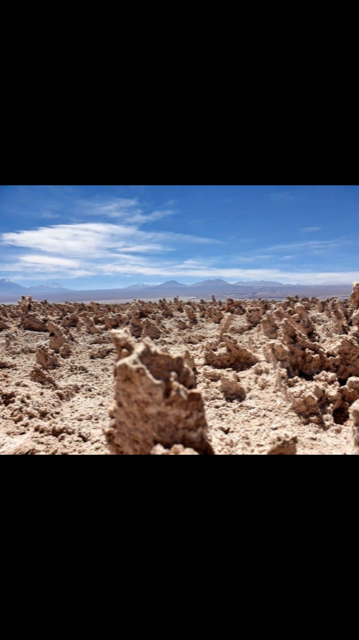
Typical movements after a stage went something like this: Bathroom. Go to tent and try get a “good spot” for sleeping. Hand sanitize. Change out of sweaty clothes. Put slippers on. Drink recovery drinks and find some shade to lie in amongst everyone else. Cheer everyone reaching Camp and help tent mates with their bags. Eat some crackers and noodles. Do some stretching. Look at other people’s blisters (best blister of the week-).. Listen to Scottish Steve making everyone laugh. Eat freeze dried evening meal and look at everyone else’s food. Jovica (overall winner) had gazpacho in the evening, while Bill (75) (UK) only ate pot noodle for the week. Finish the evening with a treat of some sort (melted haribo or chocolate) by the fire and head to bed by 7.30 for a 5am start.
Stage 5: 80km The Long March
Description of course: Around the lake shore to cross a plateau, some hard packed red sand, up a large dune, across a plateau into the Moon Valley and up some valleys home
Altitude: Starts at 7,593ft- finish at 7,780ft
Most difficult stage: the unexpected Sand storm
Stage Place: 5th female
The positives of starting to run out of food are that backpacks get lighter. I was saving my freeze dried carbonara and Doritos for the end of this day and they did not disappoint!
80km is a long distance to run, and even more so when you are underfed, tired and the terrain is so varied. We had every type of terrain during the Long March- starting on some sort of soggy marsh which I was not expecting! Strange scorched ground that was like upturned tiles, huge (cruel) sand dunes, wide open desert and a dirt road that never seemed to end. There was even a sand storm in the middle of the day which looking back on it was pretty cool (I think I got caught in it with Patrick(USA)…..The highlight of the day was being given a big juicy orange at checkpoint three or four. It was my only piece of fresh food for the week and it was glorious. Heading out of the desert onto the road that leads to Moon Valley we had been told to stay exactly on course as we were running through a patch of landmines- no off course toilet stops allowed!
At the end of every stage, you know you are near camp when you hear the crew beating the drums. By the end of this stage I was a little delusional, paranoid and the darkness started playing tricks on my mind- I kept thinking I had gone off course and was struggling to spot the pink markers. It was the only time I needed to use my poles for extra support. I ran about 34km alone without seeing anyone except the crew at the last three checkpoints and as soon as the sun went down I was completely spooked. A park ranger in a truck drove past me in the Moon Valley and I was convinced it was following me. I kept thinking the stars in the distance were the lights of the camp. So for me, hearing the faint sound of the drums was like seeing an oasis in a desert- after nearly 14 hours I was so glad to make it home (to eat my carbonara half asleep).
People were finishing this stage at all times and well into the morning- some over 24 hours on their feet. It was really emotional seeing people come in having pushed all limits. Our camp spirit Luke (UK) even wore his survival bivvy during the night section which we laughed about for hours. After the long march we had a day to rest. By that stage I had pretty much run out of food. No 1000 calorie freeze dried meals left so I think I had a pack of noodles and some crackers and sweets.
Stage 6: 13km The Final footsteps into San Pedro
Stage Place: 1st female
Really lucky to have my family (6 supporters!) fly in to finish the last stage with me. One of my brothers acted as a pacer for me which will forever remain a treasured moment. Watching everyone cross the line was incredible- so many inspirational people from all over the world from whom I learnt so much. From the crew to the runners, everyone was always genuinely supportive and that is one of the best things about the ultra-community- even if someone is passing you- you will give them kudos. So many lessons learnt- maybe for another post. A special race and one I feel I have unfinished business with……watch this space.
